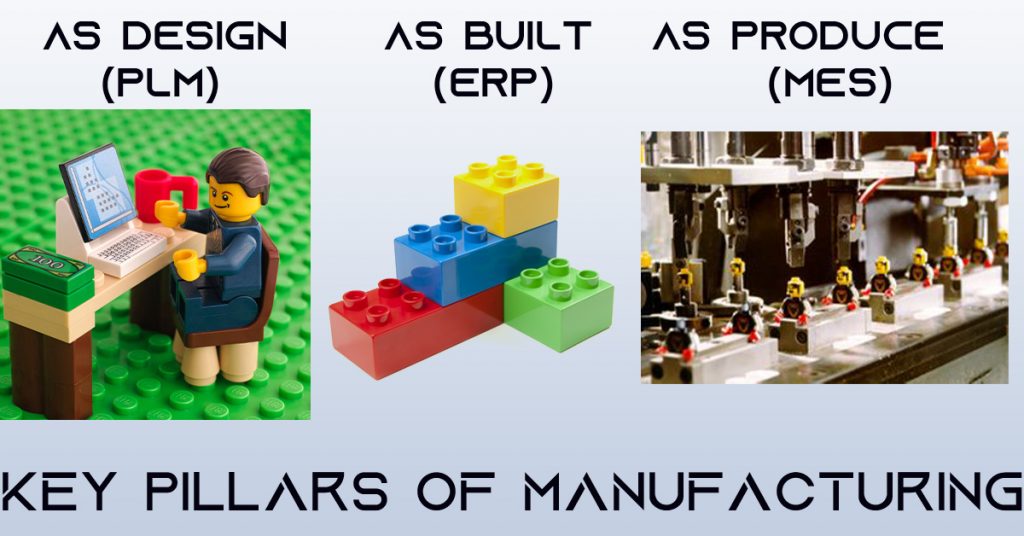
Introduction:
Manufacturing is a complex sector as well in Industry 4.0 manufacturers (Small to medium to large enterprises, OEMs) needs enterprise applications to sustain complex procedures. Three core enterprise systems (PLM | ERP | MES) in the world of manufacturing, achieving success and efficiency is crucial to stay competitive.
Product Lifecycle Management:
Beginning with product design, Product Lifecycle Management (PLM) systems keep 3D CAD data along with in-depth properties and attributes of parts/components. The product design is alteration managed, permitting continual updates and improvements, while also restricting individual gain access to and also tracing the maturity status. so, PLM consists of product data management (PDM) and CAD/CAM/CAE tools. PLM is a crucial enabler for digital change within the production business with IIoT.
Imagine building a car from scratch. PLM is like the blueprint that guides the entire process. It’s a comprehensive software system that manages a product’s journey from concept to retirement. Engineers, designers, and stakeholders collaborate within PLM to create, modify, and refine products. This includes managing design data, tracking changes, and ensuring regulatory compliance. PLM streamlines communication and reduces errors, ensuring the product development process is efficient and cost-effective.
ERP and MES:
Now, let’s shift our focus to the overall manufacturing business. Enterprise Resource Planning (ERP) is like the central nervous system of a company. It integrates all departments and processes, such as finance, HR, procurement, and inventory, into one cohesive system. Manufacturers use ERP to manage their resources effectively, plan production schedules, track raw material inventory, and streamline financial transactions. By having a centralized database, decision-makers gain real-time insights to make informed choices, optimize operations, and respond swiftly to market demands.
Zooming in even further, MES (Manufacturing Execution Systems) is the brain of the manufacturing process itself. MES connects production floor activities, equipment, and personnel to the ERP system. It monitors and controls the real-time production process, collecting data on machine performance, production rates, and quality control. MES helps optimize production, improve workflow, and minimize production bottlenecks. It ensures that production runs smoothly and efficiently, meeting quality standards and delivery deadlines.
MES connects as well monitors shop floor machines and work fixate the making sure effective execution of manufacturing procedures using manufacturing process instructions attached to each workstation and boost production efficiency. According to Manufacturing Enterprise Solutions Association MES required 11 core functions – Operations management, Dispatching production units, Product tracking and genealogy, Labor management, Maintenance management, Resource allocation and status, Performance analysis, etc.
The Synergy:
These three systems are not isolated entities; they work together harmoniously to create a powerful manufacturing ecosystem:
- Data Integration: PLM feeds critical product data into the ERP system, allowing seamless production planning based on accurate designs and specifications.
- Real-time Collaboration: MES shares production data with both PLM and ERP, facilitating better communication between design, production, and business teams. Everyone is on the same page, leading to faster decision-making.
- Efficiency and Cost-Effectiveness: The integration of PLM, ERP, and MES optimizes resource allocation, minimizes waste, and reduces manual errors. Manufacturers can control costs, improve productivity, and deliver high-quality products to the market.
- Scalability and Adaptability: As manufacturers grow, these interconnected systems provide scalability and adaptability to meet changing business needs and industry trends.
Final Thoughts:
The relationship between PLM, ERP, and MES is the backbone of manufacturing success. By collaborating and integrating these systems, manufacturers gain a competitive edge by optimizing processes, reducing costs, and accelerating product development. Either ERP and also MES is not made to optimize profitability and handle product details from concept to cradle, yet that’s precisely what PLM does. ERP knows why decisions require to be made, while MES understand exactly how to make those choices, whereas PLM optimizes business procedures and costs remain reduced. Each pillar brings various abilities to the leading edge, using them with each other can assist bring manufacturing enterprise concerning more well-shaped outcomes. Embracing these powerful tools empowers manufacturers to navigate the complex manufacturing landscape and inspire innovation in the industry. So, whether it’s creating a car or any other product, these integrated systems play a pivotal role in shaping the future of manufacturing.
To read more about our digital business service offering – For PLM, For ERP, For IIoT.


